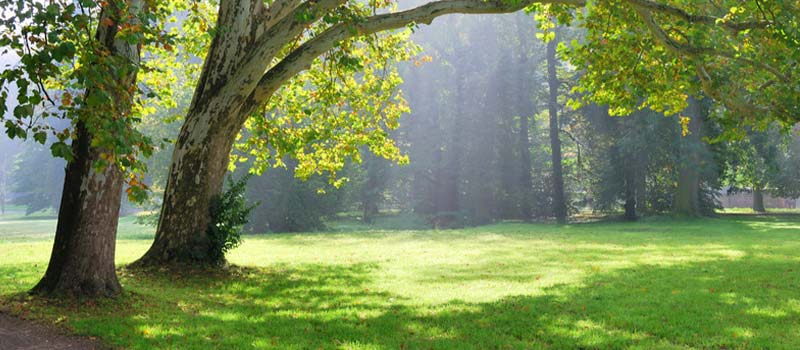Central Florida gets a lot of sunshine but that doesn’t mean every lawn receives the same amount of sunlight due to shade from trees or buildings. Before buying any turfgrass, make sure it’s a variety that matches how much sunlight your lawn receives to achieve green, fresh grass. See our tips below for determining sunlight requirements, selecting a turfgrass that is shade-friendly, and maintaining the turfgrass to protect your investment.
Sunlight Requirements
It’s crucial to determine how much sunlight your lawn receives in order to select the right turfgrass. You can do this by observing your lawn throughout the day and noting which areas receive sunlight. For greater accuracy, sketch out your lawn on paper and number each section. Keep track of sunlight levels by noting each section at timed intervals of every one or two hours from sunrise until sunset. This ‘light map’ will also come in handy if you will be designing a landscape or garden.
Keep in mind, however, that it can be hard to exactly measure how much light a lawn receives since sunlight quality, day length, and sun angle vary at different times of the year. If your lawn receives more than six hours of direct sun, then it’s considered a ‘full sun’ lawn and would require a sunlight tolerant turfgrass. On the other hand, if your lawn receives more than six hours of no direct sun, then it’s considered a ‘full shade’ lawn. Most full sun lawns will have sunlight from at least 10 a.m. through 5 p.m. whereas most full shade lawns will get a little morning sun but be shaded for at least six full hours.
There’s also ‘partial shade’ which refers to a lawn that is mostly sunny, getting shade in the morning and four to six hours of sun in the afternoon. ‘Partial sun’ is the opposite where the lawn gets a few hours of morning sun and four to six hours of shade in the afternoon. If you would like to increase the amount of sunlight your lawn receives, you have a couple of options. You could thin out tree branches to open up the lawn area to more light. Another method is to heighten the crown of the tree so more light goes through to the bottom.
By making note of which areas receive sunlight and what times, it’ll be easier to select the right turfgrass as well as plan your landscape or garden down the road.
Shade Tolerant Turfgrasses
St. Augustine turfgrasses are the most shade-tolerant when compared to other varieties of grass. Seville and Palmetto are two varieties of St. Augustine that Lake Jem Farms grows and recommends for lawns with moderate shade. Seville St. Augustine can tolerate six to seven hours of sunlight which is why it’s a favorite among landscapers for lawns with moderate shade. Palmetto St. Augustine has excellent shade tolerance as long as it’s been established and properly maintained. Palmetto grows well in partial shade and full sun, but it’s not suitable for dense shade.
Floratam St. Augustine, however, isn’t as shade tolerant as other St. Augustine varieties since it requires at least six to eight hours of sunlight a day. Another turfgrass you should avoid is Bermudagrass which has the least shade tolerance compared to other warm-season turfgrasses. Although new Bermudagrass cultivars like Tifway 419 and Celebration Bermudagrasses can handle some moderate shade conditions, they’re a far cry from being considered a shade-friendly turfgrass.
Shade Tolerant Turfgrasses
Properly maintaining your lawn requires some diligence, but it will help ensure that the turfgrass in your shady lawn is healthy and look greats.
- Apply normally recommended nitrogen rates to enhance a shaded turfgrass area, but don’t apply too much as it can hurt the turf’s shade tolerance.
- Increase the mowing height for shaded areas to increase its ability to absorb more sunlight and improve performance in those areas.
- Minimize foot traffic as it can cause excessive stress for shaded turfgrass and gradual decline.
- Shaded areas will require less water than full sunlight areas, but there could be competition from trees for soil moisture which is something to watch for.
Sod and Installation for Central Florida Lawns
It’s essential to examine your lawn’s sunlight levels so you don’t end up with a turfgrass that won’t be able to grow in your shady lawn. Lake Jem Farms offers a variety of high-quality turfgrasses to handle different levels of sunlight. Let our team of sod and installation experts help you select the right turfgrass for your shady lawn and install it properly to achieve a lawn that you’re proud to have.

